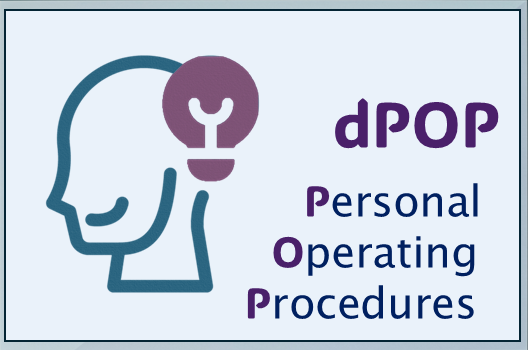dPOP’s
digital Personal Operating Procedures
The personalisation of operating procedures
The new standard is personalisation
-Improvement usually means doing something that we have never done before- Shigeo Shingo
Introduction
We recently published a White Paper with our views of the future of operating procedures in industry.
In the short time since then further evidence is emerging of the significant impact of the new buzz-word – PERSONALISATION
Ironically, the trend is accelerating in tandem with the growth of AI, and it seems to be developing almost as a counterbalance to the 1984ish fear of the impersonal machine as the new master of the digital world.
Personalisation is no longer just a nice-to-have; it’s a necessity in today’s business environment. Here’s why:
Customers Expect It
Consumers are overwhelmed with choices, and they want businesses to recognise their needs, preferences, and past interactions. Companies like Amazon and Netflix have set the standard by offering hyper-personalised recommendations, making personalised experiences the norm rather than the exception.
Boosts Customer Loyalty
When customers feel understood, they are more likely to stay loyal. A personalised experience makes them feel valued, leading to higher retention rates and brand advocacy. Research shows that customers who receive personalised experiences are significantly more likely to continue doing business with a company.
Here are some consumer trends that are worth noting:
- 71% of consumers expect companies to deliver personalised interactions, and 76% get frustrated when this doesn’t happen. (McKinsey & Company)
- 80% of shoppers are more likely to buy from brands that offer personalised experiences. (Epsilon, 2023)
- 90% of consumers say they find personalisation appealing. (Accenture, 2022)
-Be a yardstick of quality. Some people aren’t used to an environment where excellence is expected- Steve Jobs
And here is personalisation as it applies to staff:
- 94% of employees would stay longer at a company that invests in their personal learning and development. (LinkedIn Workplace Learning Report)
- 69% of employees are more likely to stay at a company for three years if they had a good induction experience. (SHRM)
- 70% of employees feel more engaged when their work experience is personalised. (Gallup)
- Companies with standard operating procedures experience 50% fewer compliance issues, highlighting the role of SOPs in regulatory adherence. (Worldmetrics)
There are two clear messages here:
- Personalisation is a growing trend among consumers
- Digital technology will aid and increase the personalisation of interactions within the workforce
The workplace is changing, and staff are not immune to consumer trends, so personalisation is also applicable to them.
This develops from the idea that you could once give customers a standard form of response, where now you need to individualise it. So too with standard operating procedures, which now need to become Personal Operating Procedures.
The new standard is personalisation!
-The world we have created is a product of our thinking; it cannot be changed without changing our thinking-Albert Einstein
A survey by the International Association of Operational Excellence Professionals found that 80% of organisations have SOPs in place but only 40% of them are effective
In hospitality, SOP’s have traditionally been paper-based manuals, but now digital technology is creating a change.
The move to digital SOP’s has been pioneered by the manufacturing and pharma industries where compliance is compulsory and working procedures need to be precise, traceable and accessible in all parts of the workplace.
The hospitality industry can learn from the experience of these industries and also apply the latest trends and developments in the L&D (learning and development) industry.
The industry will also need to consider the impact that generative AI technology will have on the future of all workplace training and development.
Background
In most traditional catering business, the SOP Manual sits in the office –
the conventional joke is “the bigger the Manual, the more difficult it is to take it down from the top shelf”.
If not a photocopy from another establishment, these Manuals are normally compiled by a central department and the layout, format, language and style can be obtuse which makes it difficult for staff to understand or relate to the content.
The system is also time consuming for managers who need to distribute updates and make sure they are added to the manual in each location.
These manuals are not easily accessible to employees and are cumbersome to use in the workplace. Also, this is a stand-alone format with no ability to integrate with other systems.
The general practice is that LOP’s, Local Operating Procedures, localised or adapted versions of the SOP’s, become the practical operating systems for many businesses.
Current Trends in Industry
Technology
The Digital technology trend in SOP’s emerged from the industrial and manufacturing industries, where the implementation of a rigid operating system is crucial for maintaining a well-organised, efficient, and totally compliant manufacturing process.
It also helps to ensure statutory compliance, meet the necessary insurance requirements and also the rigid demands of full traceability.
Learning and Retention
In tandem with these developments is a new awareness of how the current generation learn and retain information, most of which is now screen delivered.
The Sweetrush L&D Trends Report for 2024 has some interesting insights:
- The average employee spends 20 minutes a week on learning
- Social media is responsible for reducing our attention span – now down to an average of 9 seconds – particularly for flat or static content
- Learners will only invest time to learn skills if it provides a route to advancement and the learning providers can deliver what will help them learn – in a format they can relate to
In The State of Online Corporate Training in 2024, ispring research revealed the following:
- Most employees now prefer microlearning, face-to-face training, role-play simulations, and VR and AR activities
- In 2023, companies used face-to-face training 8% more often than in 2022. However this is based on the blended learning approach, which combines online and in-person training sessions.
This is an interesting finding, as the approach takes advantage of the best of both worlds: learners can interact with a skilled trainer, and with each other in real life to practice their new knowledge and skills, while continuing to learn most of the time online at their own pace.
Role-play simulations, or scenarios, are interactive learning experiences that allow employees to learn and practice new skills as they do in real life —through trial and error
Moreover, Clark Aldrich, one of the world’s most experienced designers of educational simulations, states that role-play training should be a foundation for corporate training because it helps achieve better learner engagement and knowledge retention, and remains the only innovative training method with proven effectiveness that most organisations can afford.
The Future
With 86% of training now taking place either completely or partly online, it’s clear that digital is a key element of every successful L&D strategy – The ultimate guide to designing quality elearning – Elucidat
In the near future most hospitality outlets will have access to digital technology on which operating procedures to be available at all times, to all staff, in any location, and on a range of devices.
The key question is how the information will be presented.
Various formats are currently emerging, including basic pdf’s, PowerPoint delivery, You Tube videos, Q-code prompted videos, and fully interactive, professionally authored course modules.
The most exciting development right now is that we are on the new edge of a personalised learning approach which will be driven by AI.
Generative AI models can take inputs such as text, image, audio, video, and code and generate new content into any of the modalities mentioned. For example, it can turn text inputs into an image, turn an image into a song, or turn video into text.
In the latest McKinsey Global Survey on AI, 65 percent of respondents report that their organisations are regularly using gen AI, nearly double the percentage from the previous survey just ten months ago.
Respondents’ expectations for gen AI’s impact remain as high as they were last year, with three-quarters predicting that gen AI will lead to significant or disruptive change in their industries in the years ahead.
According to Mordor Intelligence, 40% of American retailers have already adopted AI in some form, and this number is projected to leap to 80% over the next three years.
This modern technology will allow the hospitality industry to revolutionise the application of SOP’s as used in day-to-day operations.
The content can remain the same, but the style and form of delivery will be interactive, leading to a more immersive learning experience.
And the key to this immersive learning is personalisation: 77% of L&D professionals believe that personalised learning is vital for employee retention and performance improvement (Brandon Hall Group, 2020).
Personalised learning material can be adapted for each individual user,
and the Learning Leader can become an avatar in each module to respond in real time to questions or queries.
-Continuous improvement is not about the things you do well — that’s work. Continuous improvement is about removing the things that get in the way of your work. The headaches, the things that slow you down, that’s what continuous improvement is all about- Bruce Hamilton
The format will be able to direct the role-play scenarios and anticipate the individual needs of the user.
The technology will also be capable of discerning the primary learning traits of the user – aural, visual, written, and will be able to modify delivery formats to meet these traits.
Here at Customer Care Insights, we are conscious of these trends, and we are already developing personalised modules for operating procedures which will allow us to incorporate constantly evolving AI features.
Summary
The future of SOP’s lies in digitisation, and the hospitality industry now has an opportunity to leap-frog conventional digital and develop personalised modules which can incorporate AI features.
This will allow staff to have relevant, laser-focused information which will be presented in an interactive and intuitive way.
At Customer Care Insights we have learned that one of the foundations of good customer care is good operating systems which allow the operation to flourish.
In tandem with our digital personal development courses, we are now developing personalised operations modules which we call dPOP’s – digital Personal Operating Procedures.
We can take existing procedures and convert them into fully automated digital modules with the following features:
- Highly visual representation
- Voiceover attachment
- Learning validation system – quiz
- Results can be linked to the HR system
- Modules can be viewed on PC’s, tablets or phones
Call us to talk to Frank about the future – because the future is not standard anymore – its personal.
-There is nothing so useless as doing efficiently that which should not be done at all– Peter Drucker

